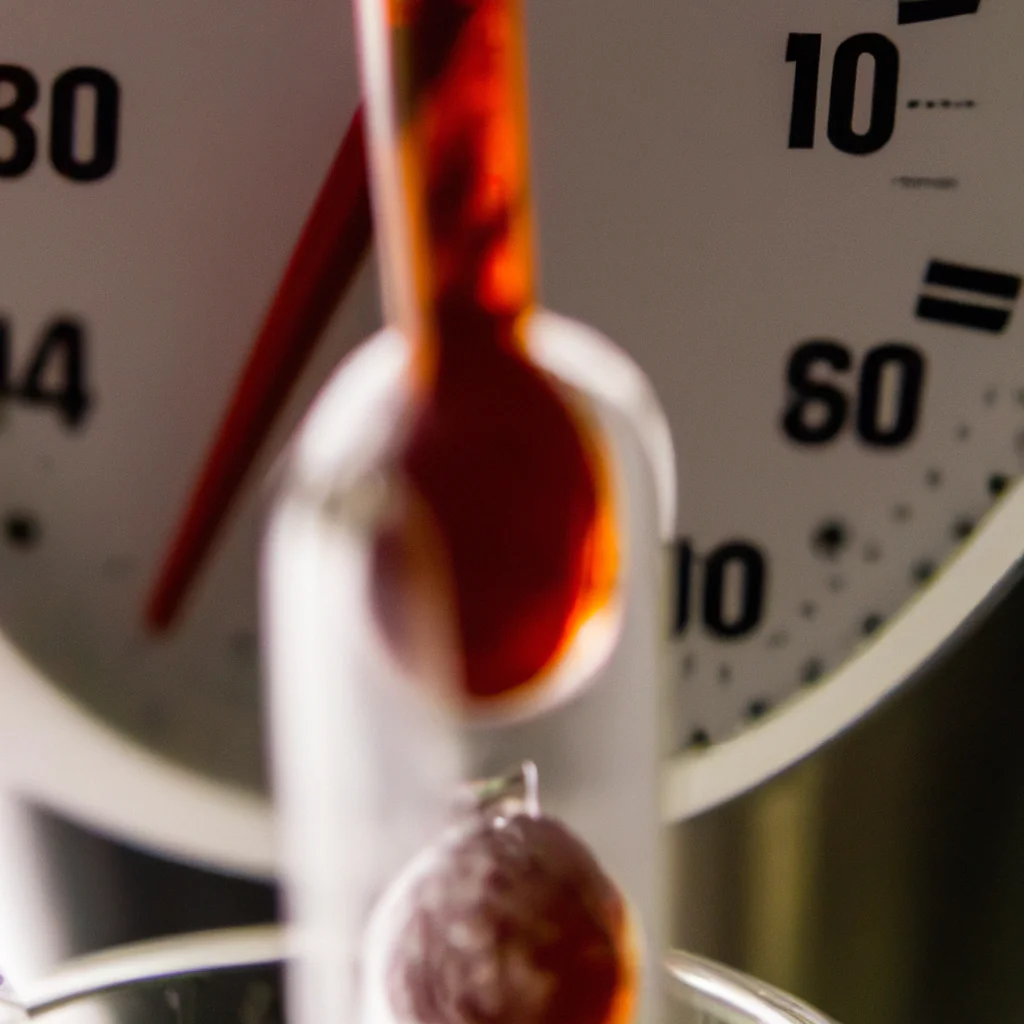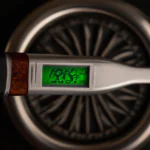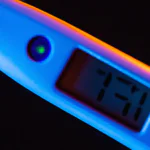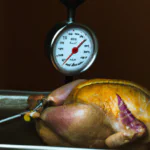Making candy can be a difficult and time-consuming task, but having the right tools can make it much easier. The most important tool is a candy thermometer, which is a specialized thermometer that is used to measure the temperature of hot liquids like sugar or honey. But what kind of thermometer should you use for candy? Can you use a meat thermometer? Or a digital thermometer? In this article, we answer all these questions so you can make the perfect candy every time.
Table of Contents
Can You Use a Meat Thermometer for Candy?
It’s important to use proper tools when dealing with hot sugar or hot oil. Even the most experienced chef can find it hard to use the right thermometer or temperature gauge. Something as simple as a candy thermometer can make all the difference when cooking sugar or oil.
A candy thermometer is much longer than a meat thermometer, with a narrower shape that allows it to safely check the temperature of hot sugar or hot oil without burning. Unlike a meat thermometer, whose temperature range is usually only limited to typical cooking temperatures, a candy thermometer has a wider range so it can measure accurate temperatures for candy-making.
The length and shape of the candy thermometer helps people to reach further and more accurately into the pot without having to worry about getting burned from the heat. The handle of the device also helps you keep your hands and arms away from the hot liquid, which could otherwise cause serious burns.
Advantages of using a candy thermometer:
- Produces precise temperatures
- Measures higher temperatures
- Longer length helps reach deeper into pot
- Handle keeps hands away from heat and prevents burning
Disadvantages of using a meat thermometer:
- Temperature range usually too low for most cooking sugars
- Shorter in length limiting how far you can reach into pot
It’s best to use the right tool for the job, whether it’s a candy thermometer or a meat thermometer.
A candy thermometer is best suited for measuring liquid temperatures when cooking sugar or other ingredients that require precise and controlled measurements. Onhte other hand,a meat thermometer is better suited for checking if your cooked meats are at their desired doneness.
The Digital Thermometer Debate: Can it work with candy?
When it comes to cooking and baking, temperature is an important factor to consider. For most recipes that include confectionary ingredients, like candy and chocolate, the temperature range is usually between 100 to 350 degrees Fahrenheit. That’s why using a thermometer when working with candy is essential in order to obtain the desired results.
Digital thermometers are a great choice for measuring temperatures while making candy as they can often measure temperatures below 0 degrees Fahrenheit and above 500 degrees Fahrenheit. This wide range of temperature makes it possible to make deep-frying, candy making and meat cooking all achievable with the same tool.
Analog thermometers, on the other hand, are not as effective when measuring temperatures for candy making as they can not measure temperatures below 100 degrees Fahrenheit or above 350 or 400 degrees Fahrenheit. However, these types of thermometers can often top out at around 200 degrees Fahrenheit which is still suitable for some confectionary heat-based recipes.
In conclusion, whether to use a digital or analog thermometer when making candy is dependent on what type of recipe you are following and what temperature range it requires because each has different capabilities. With digital thermometers, you will have the ability to measure a much wider range of temperatures than analog thermometers – so if you need precise measurements for your recipes then this type of thermometer would be the most optimal choice.
- Digital thermometers: Can measure temperatures below 0°F and above 500°F
- Analog thermometers: Can measure temperatures up to 200°F but not lower than 100°F
Don’t Sweat it! The Difference Between Candy and Meat Thermometers
When it comes to food preparation, you have a variety of tools available for measuring temperatures. Meat thermometers and candy thermometers are two of the most popular options for measuring temperature during cooking. But do they work the same way?
No, they are not. Candy thermometers have a much higher temperature range than meat thermometers. Most candy thermometers can measure up to 400 degrees Fahrenheit, while meat thermometers typically measure up to around 200 degrees Fahrenheit.
Candy thermometers are specifically designed for making candy-making and other recipes requiring precise temperatures. The wider temperature range allows more control over the cooking process. Conversely, meat thermometers are intended for use with meats and poultry and can provide a more accurate reading at lower temperatures.
One important thing to consider when using either type of thermometer is that they all require calibration before being used. This ensures that your readings will be as accurate as possible. Be sure to check your instructions carefully to determine how your device should be calibrated.
Choosing the right type of thermometer for the job is key to achieving perfect results in your culinary creations. Here’s a look at some of the key differences between candy and meat thermometers:
- Temperature range: As mentioned before, candy thermometers generally measure temperatures up to 400°F while most meat thermometers top out at 200° F or less.
- Accuracy: Candy thermometers are very accurate and can produce extremely precise results. Meat thermometers tend to have less accuracy, but still provide careful cooks with reliable results.
- Function: Candy thermometers are designed for delicate recipes that require specific temperatures, whereas meat thermometers are simply used to make sure food has reached a safe temperature.
Candy and meat thermometers both offer precision when it comes to food preparation and ensure that everything comes out just right. Understanding the differences between the two types of devices will help you make an informed decision on which one best suits your needs.

When You Don’t Have a Candy Thermometer: Can Regular Thermometers Work?
Candy making is a fun and delicious activity, but one that also requires precision. If you’re like many other home chefs, you may not have access to a specialized candy thermometer.
However, it is possible to use a regular thermometer to make candy! If your thermometer reads up to 392 degrees Fahrenheit (200 Degrees Celsius), then it can be used for candy making. This type of thermometer is an old-fashioned analog one, made of metal and coils.
It’s important to use the same temperature for all of your recipes. Depending on the type of candy you want to make, such as fondant, divinity, there are different temperatures that are required for perfect results:
- Fondant: 230 – 255° F (110 – 124° C)
- Divinity: 242 – 248° F (117- 120° C)
- Caramel: 310 – 350° F (154 – 177° C)
- Fudge: 234 – 240° F (112- 115° C)
- Hard Crack: 300° F (149° C)
When checking to see if your candy has reached the desired temperature, many suggested stirring the mixture while you’re checking it. Giving it a good stir will even out the temperature throughout the mixture so get more precise readings.
Cooking with a regular thermometer may require some patience and practice at first. However, once you find the right readings for each type of candy recipe, you’ll start getting consistent results!
Don’t Have a Thermometer? Can You Still Make Hard Candy?
Making hard candy without the help of a thermometer is certainly possible, but that doesn’t mean it will necessarily be easy. If you’re up for the challenge, here’s what you need to know to get started.
The Test
When testing if your sugar syrup has reached the appropriate stage for hard candy, you can use the ‘Thread Test.’ To do this, drop small amounts of the syrup into cold water and watch for a few moments. If the syrup forms brittle threads that snap when bent, then your mixture is ready.
The Technique
If you want to take your candy making skills up a notch, here are three things to keep in mind as you perfect your technique:
- Timing: The entire process should go quickly. If left for too long, your candy may become too thick to work with.
- Temperature: Use boiling water or heat the sugar syrup to 300-degrees Fahrenheit.
- Spreading: Immediately after pouring the mixture onto wax paper, spread it out into a thin sheet while it’s still hot. Once cooled and hardened, break into pieces.
Conclusion
Making hard candy at home is more satisfaction than science. Experiment and find what works best for you. With the right timing and patience, you can create delicious homemade candies without using an exact thermometer.
No Thermometer? Here’s What You Can Use Instead
The cold-water method is a classic and effective test to estimate the temperature of your candy. It has been used by generations of cooks and candy makers making all kinds of sweet treats, from fudge to toffee. With just a few supplies, this trick is easy to do in the comfort of your own kitchen.
To start:
- You will need one or two cups of cold water, a heatproof bowl, and a spoon.
- Fill your heatproof bowl with the cold water and add one or two spoonfuls of the melted candy you’re testing.
- You’ll need to stir the water together with the melted candy until it’s fully combined and cools enough to form a semi-solid mass.
You can also experiment with different “stages” of cooling by testing with both one and two spoonfuls of candy. One spoonful will cool faster, enabling you to observe how quickly the candy reaches each stage in terms of firmness.
- Soft Ball Stage: The candy should be able to stick together when pressed between your fingers without feeling greasy.
- Firm Ball Stage: Press it between your fingers, and it should not bend or flatten, but hold its shape as a small ball.
- Hard Ball Stage: Put it in between your fingers and it should bend but not flatten.
- Soft Crack: A drop should “snap” off when dropped into cold water but still feel sticky when chewed.
- Hard Crack: A drop will split into brittle threads that feel crunchy when chewed.
Remember: The key is to keep stirring and continuously test for each stage until you are satisfied with the results!




